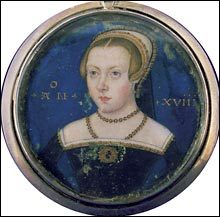
|
| ©Telegraph |
| The miniature that Dr Starkey believes is of Lady Jane Grey |
The great unsolved mystery of what Lady Jane Grey, England's shortest reigning monarch, looked like may finally have been cracked, thanks to a piece of jewellery, a flower related to the cabbage and the historian David Starkey.
Dr Starkey, a Tudor specialist, claimed yesterday that he was "90 per cent certain" that he had succeeded in identifying the first contemporary portrait of Jane Grey, the pious Protestant pawn who was queen for nine days in 1553 before being beheaded at the Tower of London.
The portrait, less than two inches in diameter, belongs to an American collection and is known to date from the mid-16th century. The sitter has never before been named, but Dr Starkey said that he had identified her as Jane Grey from a brooch on her dress and a highly symbolic jewellery spray of foliage behind it, linking her to her husband.
Jane Grey is the only English monarch since 1485 of whom no proven contemporary portrait survives. Many candidates have appeared and been dismissed or found to be imagined likenesses painted after her death.
Dr Starkey, best known for his television series on the kings and queens of England, said: "It's terribly exciting because she has been so elusive. I think that we've now got a full hand of monarchs.
"I have to qualify this by saying that I am 90 per cent certain, but not 100 per cent. I'm delighted, but I'm in modified rapture."
The discovery, at the Yale Center for British Art in America, will be a blow to Britain's National Portrait Gallery, which owns contemporary pictures of Henry VII and every subsequent monarch except Jane Grey.
Dr Starkey accused the gallery of wasting public money last year after it spent a rumoured £100,000 on another supposed portrait of Jane Grey found in a house in Streatham, south London, but painted 50 years after her death.
The gallery said it was a copy of a lost contemporary work but Dr Starkey said that there was no evidence for this.
He described the new portrait as "attractive, though not very beautiful, with a typical Tudor face, reddish/auburn hair, blue/grey eyes, fine lips, a red rose mouth and a snub nose". He added: "There is a suggestion that she is quite short, but this is no pushover girl. She has a highly intelligent determined face."
Jane Grey's date of birth is not known, so it is impossible to know her age in the portrait, but Dr Starkey put it at between 16 and 18.
His detective work began when he saw a photograph of the miniature, painted on vellum, in a book. He said: "Almost all the early miniatures such as this were of royal subjects. This one struck me instantly and I thought it had to be of Lady Jane.
"What I noticed was the evident youth of the sitter. It would be unusual for someone to sit for a miniature unless they had very high status."
But it was the jewellery that eventually gave the evidence. He found that the brooch in the portrait matched one in an inventory of Jane Grey's possessions at the British Library. It is described as being made of gold with an agate centre and bearing the profile of a classical face.
He also worked out that the "foliage" behind the brooch was the badge of the Dudley family. John Dudley, the Duke of Northumberland, effectively ruled England in the last days of Edward VI, the sickly boy king whose death propelled Jane to the throne. The duke married one of his four sons, Guildford Dudley, to Jane Grey, to assert his control of the throne.
The foliage includes the four-petalled gillyflower, a relative of the cabbage.
"Gilly" was the nickname or rebus of Guildford Dudley. A 16th-century stone carving of the gillyflower survives in a wall of the Beauchamp Tower at the Tower of London where Guildford, his father, and his three brothers were incarcerated with Lady Jane before their executions.
Dr Starkey believes the portrait was made by Lavinia Teerlinc, the Belgian miniaturist who succeeded Hans Holbein as Henry VIII's court painter. It may have been painted to record Jane and Guildford's wedding or while Jane was at the Tower awaiting her death.
Very small gold decorations are sewn into the top of her dress and similar items are listed in the inventory, but Dr Starkey said it was impossible to match them exactly.
He said: "If I had been able categorically to identify them, I could be 100 per cent certain about this miniature."
The Yale Center paid £760 for the miniature - and a second painting, supposedly a Holbein - at Sotheby's in 1970. Its value will be hugely enhanced if the historian's findings are accepted.
The Yale Center's "Jane Grey" goes on display at the Philip Mould Gallery at 29 Dover Street, London W1, tomorrow in Lost Faces, an exhibition of newly discovered royal Tudor portraits. It runs until March 18.



Reader Comments
to our Newsletter